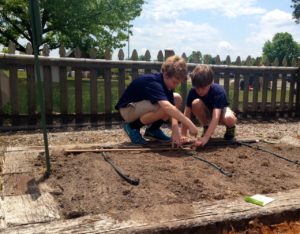Kids Dig

To view the photo-rich magazine version, click here.
Originally appears in the Spring 2022 issue.
By Todd Beasley
While teaching 5th-grade in Columbia, South Carolina, I had the great experience of building a gardening program that resulted in 13 thematic learning gardens spread across campus. From start to finish, students led the way in all aspects and at least one new garden was created each year. Only a few staff would know what the new garden would be and where it would be located. Rumors would fly each year during the preparation of a garden, especially during one notable year. The on-site outline looked like a giant bullseye and word on the street indicated that it was a target site for a skydiving team. As the plants began to fill the quadrants of the ‘bullseye,’ the new gossip was that the garden was to become a plant labyrinth. In the end, we surprised everyone with a ceremonial event by the Chief of the Cherokee Nation in South Carolina dedicating what became the largest medicine wheel in the state.
Teachers and students are known for their creativity, and garden projects allow for artistic, outdoor extensions of classroom lessons. The more commonly designed youth gardens include the Native American garden, butterfly and hummingbird garden, children’s garden, and, of course, the edible approach. Garden projects allow project-based learning to be infused into curricula, while having positive long-term environmental consequences and perhaps capturing the interests of students who may go on to continue their studies from lessons learned in outdoor educational settings.
What is often missing is how to involve students for the whole year, including even before the planting. Students from 5th through 12th-grade can easily learn the basic steps of landscape design and produce intriguing plane-view plans that allow nearly all interests to be captured and included. Using a six-step approach that can be modified for any teaching disposition, the elements of art and principles of design can be incorporated even if you don’t have a green thumb or a landscape architecture degree.
This content is restricted to subscribers only.
If you are not yet a subscriber, please consider taking out a subscription here.
If you are an existing subscriber, kindly log in or contact us at info@greenteacher.com for more information.










